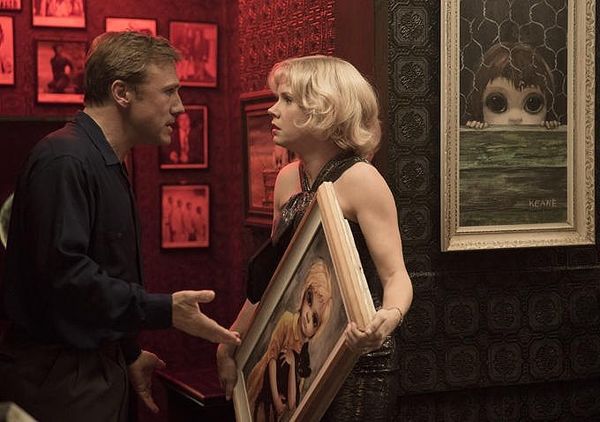Eye For Film >> Movies >> Big Eyes (2014) Film Review
Big Eyes
Reviewed by: Anne-Katrin Titze

Tim Burton's Big Eyes paints a vivid portrait of Margaret and Walter Keane's relationship and how through kitsch, commerce and fraud, they shook up the molecules of the art world in the early 1960s. The paintings of big-eyed forlorn orphans, each clutching a puppy, a kitten, a flower or some bright object to heighten their forlornness, that Walter took credit for and promoted brilliantly and unscrupulously, were actually produced solely by his wife Margaret.
Amy Adams, in a nuanced and tender performance, leads us deeply into the dilemma of a single mother and artist in mid-century America. Burton shows her locked in the secrecy of her closet atelier, hiding the truth from everyone, even her own daughter, while Walter revolutionises the mass production of suburban art in a wild song and dance routine, convinced that nobody will ever find out the truth. There are moments when Adams seems uncomfortable, for instance when she places her fingers on her front teeth in thought or while inspecting Campbell soup cans, of all things.

Christoph Waltz's intensely plotting Walter pulls the strings maniacally on what looks like the set of a musical for MGM and exemplifies that putting a name on something doesn't make it yours. An American In Paris gives birth from Andy Warhol to Jeff Koons. The plot of Singin' In The Rain credits the real artist and Margaret Keane learns how to stand up for herself.
The mood shifts from a sunny Arthur Freed production to an appropriately dark re-writing of Rumpelstiltskin where the queen is the one who can spin straw into gold and naming is key. Costume designer Colleen Atwood puts the cast in brash signifying clothes. Penny loafers and rolled-up denim, something Gene Kelly would wear while strolling by. I actually wished he would. And it seems as if Adams and Waltz did too. "Eyes are how I express my emotion," says Margaret who was deaf for a while as a child, yet we cannot really grasp what those emotions are.
Burton does not think he needs to make up his mind about the tone of the movie. It is like a child ordering an ice cream with five kinds of toppings. The flavors cancel each other out. At times, scenes seem to be directed by someone who has a bag over his head without the big eyes cut out.
Waltz looks as though he fell into his role from a swinging vine. With the exception of a flashy madcap courtroom scene, Walter's phony devilry overwhelms his charm. Self-important and cold, he tells his wife that "sadly, people don't buy lady-art" as he schmoozes with movie stars like Kim Novak, Natalie Wood and Bob Hope.
Jason Schwartzman's Ruben rejects the work as a gallery owner with taste and standards. Burton wastes him by letting him huff and puff and stand around indignantly. The story around how Walter Keane managed to get a painting into the 1964 World's Fair in New York through sheer slimeballing is fascinating history. When he throws matches at his terrified family we enter another kind of film.
Krysten Ritter's DeeAnn, Margaret's only friend, suspects foul play all along, whereas Danny Huston's newspaper columnist, Dick Nolan, profits heavily himself from Walter's shenanigans. Sometimes you need critics to protect the public, concludes John Canaday (Terence Stamp) about the Keane art. What compels a grown man to paint like this, Walter is being asked on TV, while his wife has what looks like the Tim Burton version of a nervous breakdown. As she's shopping in a supermarket, suddenly everybody's dark-rimmed eyes start to look like her paintings.
Questions of gender cross swords with those of art and religion. A scene, nestled in a spot during the chaos of opening the Keane Gallery, and almost forgotten, has Margaret go to confession. Insecure, because she grew up Methodist, she asks if she could confess anyway. The priest welcomes her warmly and a second later gives her the worst possible advice, as if it were from a Buñuel film.
As the end credits roll, a photograph of the real Margaret Keane today at 87, an elegant and friendly looking woman, appears. It is obvious that Amy Adams wanted to give her credit with a delicate performance and not stab her in the back by reducing her to a caricature. Now, if only the director had resisted the five toppings.
Reviewed on: 19 Dec 2014

















